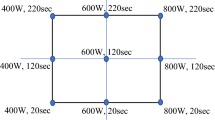Abstract
A laboratory-scale electrodewatering system, incorporating an electric field as an additional driving force to conventional pressure dewatering, has been developed to decrease the water content of sludges generated in wastewater treatment. Consisting of a piston-type filter press, a power supply and a data acquisition system, the electrodewatering system’s performance was evaluated as a function of applied pressure, applied voltage, sludge type and filtration time. Experiments were carried out using sewage sludges with the electric field up to 120 V/cm and pressure ranging from 98.1 to 392.4 kPa. Electrodewatering involving a combination of electric field and pressure enhances both the dewatering rate and final dewatered volume. The final water content of sewage sludges in the electrodewatering system can be reduced to 62 wt%, as compared to 78 wt% achieved with the pressure filtration alone. The electrodewatering system shows the potential to be an effective method for reducing the water content in sludges.
Similar content being viewed by others
References
Barton, W. A., Miller, S. A. and Veal, C. J., “The Electrodewatering of Sewage Sludge,”Drying Technology,17(3), 497 (1999).
Gazber, S., Abadie, J. M. and Colin, F., “Combined Action of Electro-Osmotic Drainage And Mechanical Compression on Sludge Dewatering,”Water. Sci. Tech.,30(8), 169 (1994).
Heath, L. W. and Demirel, T., “Pressurized Electro-Osmotic Dewatering,” Engineering Foundation Conference on Flocculation Sedimentation and Consolidation, Sea Island, Georgia (1994).
Ju, S., Weber, M. E. and Mujumder, A. S., “Electroosmotic Dewatering of Bentonite Suspension,”Separation Technology,1, 214 (1991).
Kondoh, S. and Hiraoka, M., “Commercialization of Pressurized Electroosmotic Dehydrator,”Wat. Sci. Tech.,22, 259 (1990).
Kuhn, R. and Hoffstetter, S., “Capillary Electrophoresis: Principles and Practice,” Springer-Verlag Berlin Heidelberg (1993).
Orsat, V., Raghavan, G. S. V. and Norris, E. R., “Food Processing Waste Dewatering by Electroosmosis,”Can. Agric. Eng.,38(1), 1 (1996).
Smollen, M. and Kafaar, A., “Electroosmotically Enhanced Sludge Dewatering: Pilot-Plant Study,”Wat. Sci. Tech.,30(8), 159 (1994).
Sung, D. J. and Parekh, B. K., “Statical Evaluation of Hyperbaric Filtration for Fine Coal Dewatering,”Korean J. Chem. Eng.,13, 304 (1996).
Shin, Y. S., Kim H. C. and Chun, H. S., “Drying of Water Treatment Process Sludge in a Fluidized Bed Dryer,”Korean J. Chem. Eng.,17, 22 (2000).
Tchobanoglous, G. and Burton, F. L., “Wastewater Engineering, Treatment, Disposal Reuse” McGraw-Hill, Inc. (1991).
Vijh, A. K. and Novak, J. P., “A New Theoretical Approach to Electroosmotic Dewatering (EOD) Based on Non-Equilibrium Thermo-dynamics,”Drying Technology,15(2), 699 (1997).
Yoshisa, H., “Practical Aspects of Dewatering Enhanced by Electroosmosis,”Drying Technology,4(4), 787 (1993).
Author information
Authors and Affiliations
Corresponding author
Rights and permissions
About this article
Cite this article
Lee, JK., Shin, HS., Park, CJ. et al. Performance evaluation of electrodewatering system for sewage sludges. Korean J. Chem. Eng. 19, 41–45 (2002). https://doi.org/10.1007/BF02706872
Received:
Accepted:
Issue Date:
DOI: https://doi.org/10.1007/BF02706872




